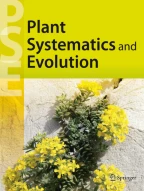208Accesses
12Citations
3Altmetric
Abstract
InAsphodelus aestivus the large number of showy flowers opened per inflorescence, high nectar and pollen production, and absence of automatic self-pollination, so that insect visitation is necessary for pollination, indicate that cross-fertilization is favoured. LargeHymenoptera are the main pollinators. Hand self-pollinations result in some degree of fruit-set, but cross-pollination also yield low fruit- and seed-set. The perennial habit and polyploid status are in agreement with the breeding system of this species, with sexual reproduction being rather inefficient and active vegetative propagation.
This is a preview of subscription content,log in via an institution to check access.
Access this article
Subscribe and save
- Get 10 units per month
- Download Article/Chapter or eBook
- 1 Unit = 1 Article or 1 Chapter
- Cancel anytime
Buy Now
Price includes VAT (Japan)
Instant access to the full article PDF.
Similar content being viewed by others
References
Brewbaker, J. L., Gorrez, D. D., 1967: Genetics of self-incompatibility in the monocot generaAnanas (pineapple) andGasteria. — Amer. J. Bot.54: 611–616.
Corbet, S. A., 1990: Pollination and the weather. — Israel J. Bot.39: 13–30.
Cruden, R. W., 1977: Pollen-ovule ratios: a conservative indicator of breeding systems in flowering plants. — Evolution31: 32–46.
—, 1983: Studying nectar? Some observations on the art. — InBentley, B., Elias, T., (Eds): The biology of nectaries, pp. 223–241. — New York: Columbia University Press.
—, —, 1983: Patterns of nectar production and plant-pollinator coevolution. — InBentley, B., Elias, T., (Eds): The biology of nectaries, pp. 80–125. — New York: Columbia University Press.
Charlesworth, D., 1989: Why do plants produce so many more ovules than seeds? — Nature338: 21–22.
—, 1987: Inbreeding depression and its evolutionary consequences. — Ann. Rev. Ecol. Syst.18: 237–268.
Dafni, A., Dukas, R., 1986: Insect and wind pollination inUrginea maritima (Liliaceae). — Pl. Syst. Evol.154: 1–10.
De Wet, J. M., 1980: Origin of polyploids. — InLewis, W. H., (Ed.): Polyploidy: biological relevance, pp. 3–16. — New York: Plenum Press.
Díaz Lifante, Z., 1990: Germinación del polen enAsphodelus L. — InBlanca, G., Díaz de la Guardia, C., Fernández, M. C., Garrido, M., Rodríguez-García, M. I., Romero García, A. T., (Eds): Polen, esporas y sus aplicaciones, pp. 135–140. VII Simposio de Palinología. — Granada.
—, 1995: Reproductive biology and hybridization of the species ofAsphodelus sect.Verinea (Pomel)Baker (Asphodelaceae). — Bot. Helvet.105: 97–109.
Fahn, A., 1982: Anatomía vegetal. — Madrid: Pirámide.
Gustafsson, A., 1948: Polyploidy, life form and vegetative reproduction. — Hereditas34: 1–22.
Harder, L. D., 1986: Effects of nectar concentration and flower depth on flower handling efficiency of bumblebees. — Oecologia69: 309–315.
Jackson, R. C., 1976: Evolution and systematic significance of polyploidy. — Annu. Rev. Ecol. Syst.7: 209–234.
Klekowski, E. J., 1984: Mutational load in clonal plants: a study of two fern species. — Evolution38: 417–426.
Kugler, H., 1977: Zur Bestäubung mediterraner Frühjahrsblüher. — Flora166: 43–64.
Lande, R., Schemske, D. W., 1985: The evolution of self-fertilization and inbreeding depression in plants. I. Genetic models. — Evolution39: 24–40.
Lewis, W. H., 1980: Polyploidy in species populations. — InLewis, W. H., (Ed.): Polyploidy: biological relevance, pp. 103–144. — New York: Plenum Press.
Loehle, C., 1987: Partitioning of reproductive effort in clonal plants: a benefit-cost model. — Oikos49: 199–208.
Loew, E., Kirschner, O., 1911:Asphodelus L. — InKirschner, O., Loew, E., Schröter, C., (Eds): Lebensgeschichte der Blütenpflanzen Mitteleuropas1(3), pp. 296–303. — Stuttgart: Ulmer.
Obeso, J. R., Villalba, C. J., 1991: Morfología y reproducción en dos poblaciones deAsphodelus albusMiller (Liliaceae). — Anales Jard. Bot. Madrid48: 189–200.
Pantis, J. D., Stamou, G. P., 1991: Spatial distribution and density dependent growth and flowering ofAsphodelus aestivusBrot. — Vegetatio97: 89–96.
Pleasants, J. M., Chaplin, S. J., 1983: Nectar production rates inAsclepias quadrifolia: causes and consequences of individual variation. — Oecologia59: 232–238.
Richards, A. J., 1986: Plant breeding systems. — London: Chapman & Hall.
Sass, J. E., 1940: Elements of botanical microtechnique. — New York: Hill Book.
Schemske, D. W., 1983: Breeding system and habitat effects on fitness components in three neotropicalCostus (Zingiberaceae). — Evolution37: 523–539.
—, 1985: The evolution of self-fertilization and inbreeding depression in plants. II. Empirical observations. — Evolution39: 41–52.
Schuster, A., Non-Meir, I., Heyn, C., Dafni, A., 1993: Pollination-dependent female reproductive success in a self-compatible outcrosser,Asphodelus aestivusBrot. — New Phytol.123: 165–174.
Sears, E. R., 1937: Cytological phenomena connected with self-sterility in the flowering plants. — Genetics22: 130–181.
Seavey, S. R., Bawa, K. S., 1986: Late-acting self-incompatibility in angiosperms. — Bot. Rev.52: 195–219.
Smith, G. F., Van Wyk, B. E., 1991: Generic relationships in theAlooideae (Asphodelaceae). — Taxon40: 557–581.
—, 1992: Notes on the microfaunal complement and pollination mechanisms ofPoellnitzia rubriflora (Asphodelaceae: Alooideae): an example of mite-flower domatia association. — Taxon41: 437–450.
Stebbins, G. L., 1938: Cytological characteristics associated with the different growth habits in the dicotyledons. — Amer. J. Bot.25: 189–198.
—, 1971: Chromosomal evolution in higher plants. — London: Edward Arnold.
—, 1980: Polyploidy in plants: unsolved problems and prospects. — InLewis, W. H., (Ed.): Polyploidy, biological relevance, pp. 495–520. — New York: Plenum Press.
Wiens, D., 1984: Ovule survivorship, broad size, life-history, breeding systems and reproductive success in plants. — Oecologia64: 47–53.
—, 1987: Reproductive success, spontaneous embryo abortion and genetic load in flowering plants. — Oecologia71: 501–509.
Willemse, M. T. M., Franssen-Verheijen, M. A. W., 1986: Stylar development in the open flower ofGasteria verrucosa (Mill.)H. Duval. — Acta Bot. Neerl.35: 297–309.
Author information
Authors and Affiliations
Departamento de Biología Vegetal y Ecología, Facultad de Biología, Universidad de Sevilla, Apdo. correos 1095, E-41080, Sevilla, Spain
Zoila Díaz Lifante
- Zoila Díaz Lifante
You can also search for this author inPubMed Google Scholar
Rights and permissions
About this article
Cite this article
Díaz Lifante, Z. Reproductive biology ofAsphodelus aestivus (Asphodelaceae).Pl Syst Evol200, 177–191 (1996). https://doi.org/10.1007/BF00984934
Received:
Revised:
Accepted:
Issue Date:
Share this article
Anyone you share the following link with will be able to read this content:
Sorry, a shareable link is not currently available for this article.
Provided by the Springer Nature SharedIt content-sharing initiative


